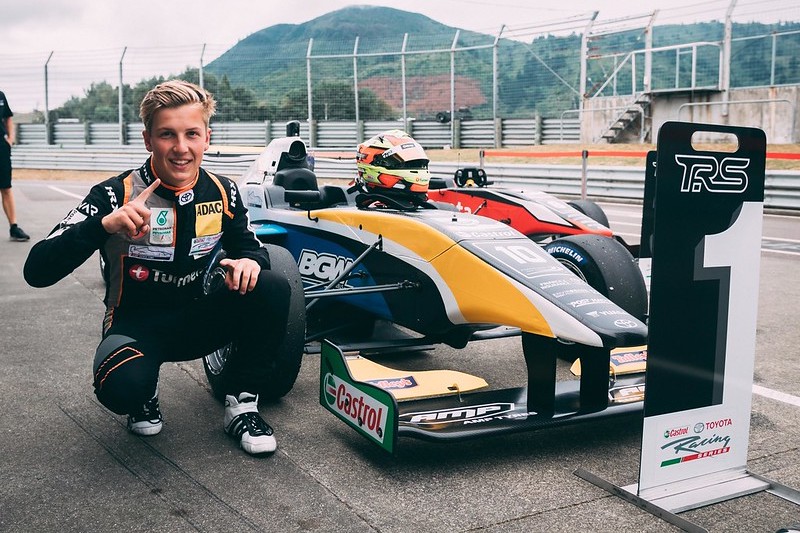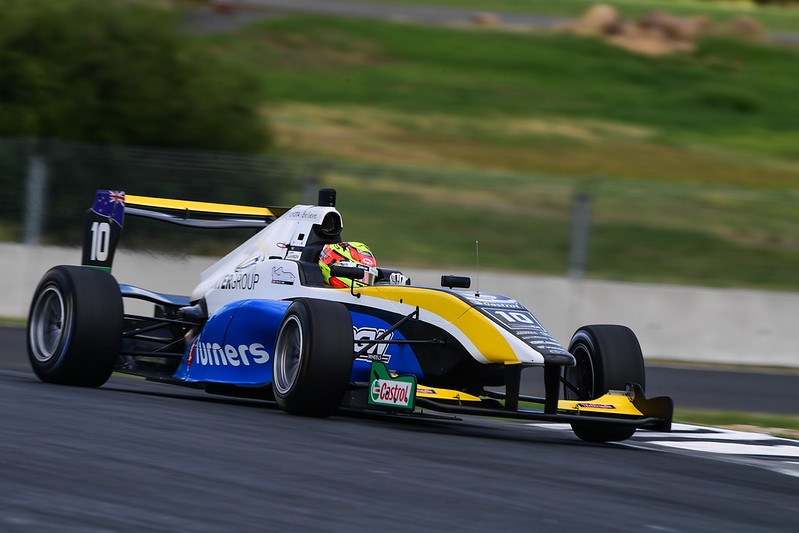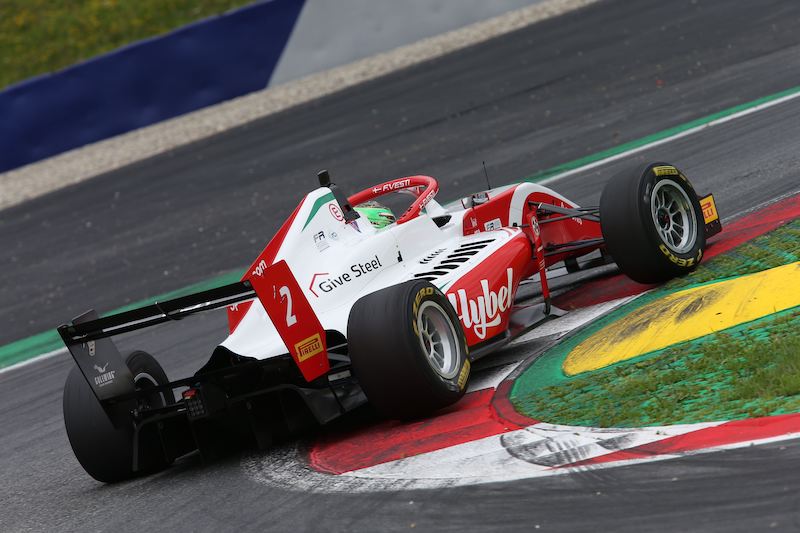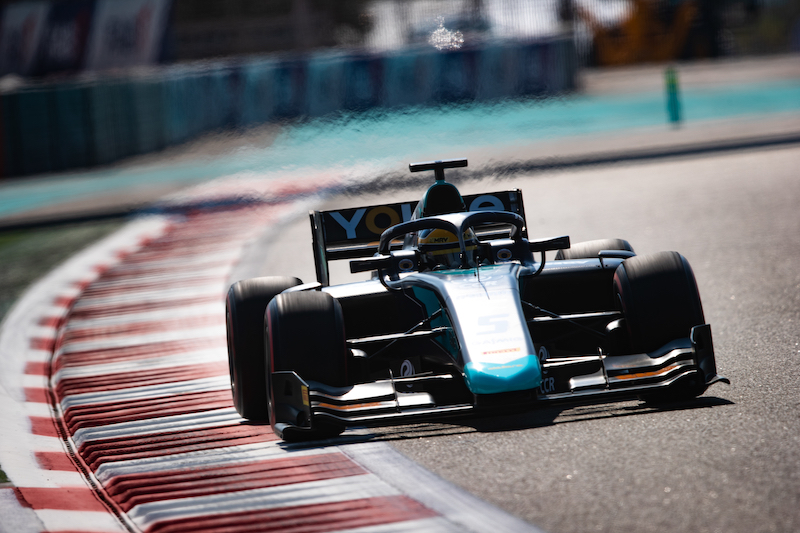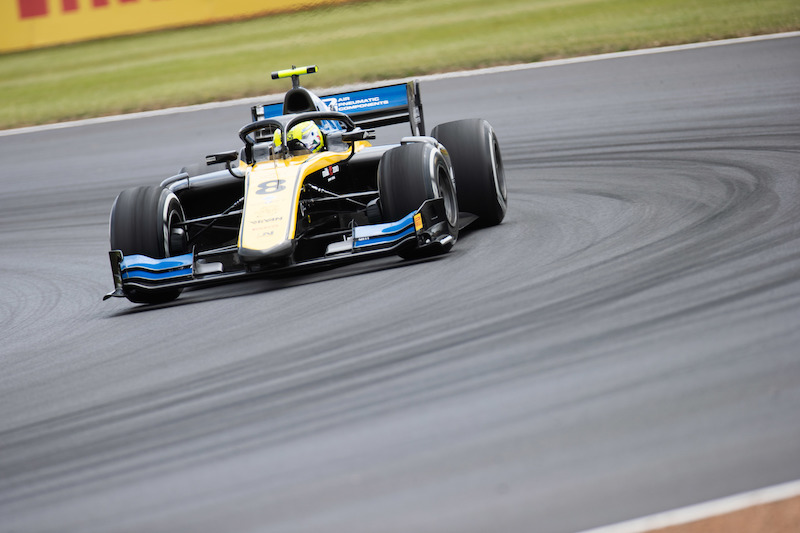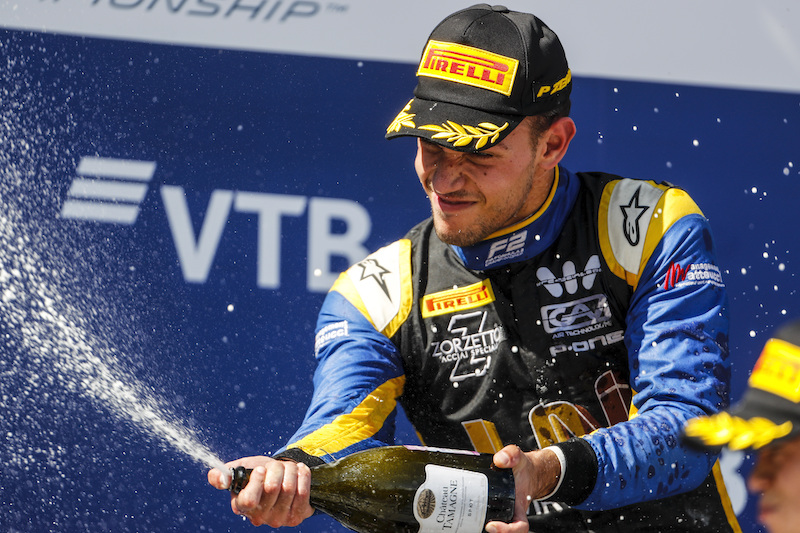The penultimate part of our countdown of the best junior single-seater drivers of 2019 features those we placed from 20th to 11th
20. Liam Lawson
Up 12
Stunning TRS success earned Red Bull backing for dual European campaign
Lawson’s end-of-2018 Asian Formula 3 cameo resulted in three dominant wins out of three, and set the tone for 2019.
He began with his local Toyota Racing Series, a series he always aspired to race in once he was old enough, and beat Marcus Armstrong in a thrilling title duel. What impressed was that Lawson immediately established himself in M2 Competition’s line-up, surprising his team bosses. He won the season opener from pole, and the third race by 9.921 seconds after passing his team-mates.
Further examples of brilliant racecraft, in all weather conditions, meant there were podiums even when he started poorly. An ambitious move ultimately won Lawson the New Zealand Grand Prix and the overall title, and he became a Red Bull junior within days. Arguably, no driver excited junior single-seater observers as much as Lawson did in TRS.
Like fellow Red Bull recruit Yuki Tsunoda, Lawson was placed in a dual campaign of Euroformula Open (with Motopark) and FIA F3 (with MP Motorsport), and was stellar in both – albeit repeating the overambition that ruffled rivals in TRS.
Lawson only took two EF Open poles despite being the fastest driver, and he could have won the first four races of the year. He won two, in style, but the second Paul Ricard race and Pau GP were lost to team-mate clashes he was at fault for. Once juggling both series his results dipped, and a clash with Tsunoda lost him a Spa-Francorchamps win.
Lawson was also MP Motorsport’s fastest driver in FIA F3, and he dialled down the risk when podiums were up for grabs – including a thrilling victory battle with Tsunoda at Monza. A month later he repeated the duel in EF Open and won. Holding onto his other FIA F3 podium finish at Silverstone and his run from 20th to seventh in the Macau Grand Prix were also highlights.
19. Frederik Vesti
New entry
Prema driver ran away to inaugural European Formula Regional title
There’s no shame in saying it was an incomplete Vesti that romped to 13 wins in Formula Regional European Championship this year, certainly as it opens up the question of how much greater a driver he could be in 2020.
Qualifying push laps and race starts were Vesti’s biggest weakness for much of the year, which he made up for with an intimate understanding of how to push the Pirelli tyres in races, and particularly clean and strong racecraft.
This was displayed in multiple ways, most memorably in the middle of the season when he held off last-lap suspension failure and Prema team-mate Olli Caldwell to win at the Hungaroring, and overcame a slow start and then diffuser damage from being punted off track to win the opening two Red Bull Ring races. Vesti is the first to admit that overtaking is tough in Formula Regional.
A well-executed overtake earned Vesti a win at Barcelona two rounds later, the first time Prema hadn’t been the fastest team, and it was a formality that he took two dominant wins at Mugello despite rival US Racing continuing its strong form.
Vesti was rightly promoted to Prema’s FIA F3 line-up in place of the injured Jehan Daruvala for the Macau GP, and he did a top job qualifying seventh (ahead of team-mate Armstrong) before a strong drive from 18th to 10th in the grand prix itself.
Further reading
How ?incomplete? Vesti was the class of Formula Regional Europe
18. Callum Ilott
No change
F2 rookie impressed with progress and fortitude
Ilott went through some difficult moments in 2019, but while he might not be satisfied with 11th place in the Formula 2 standings, his strong end to his rookie season was particularly impressive, and even more so given the circumstances.
Crashing out of qualifying for round one in Bahrain was an ignominious start, but by Barcelona he’d qualified in the top five, and ended that weekend with a sprint race podium. In Monaco he topped his qualifying group, joining Nyck de Vries on the front row, only for his car to cruelly shut down before the start with an electrical issue.
Barcelona was a bit of a false dawn in terms of race performances, because over the summer Ilott struggled to make his tyres last and turn his fine qualifying speed – he ended the year with the fifth best average in what had been considered a midfield team – into representative results.
Ilott was particularly badly hit by the awful events of Spa, losing a close friend (and twice a past team-mate) in Anthoine Hubert, while team-mate Juan Manuel Correa was also sidelined and in a serious condition. Ilott went to Monza a few days later as the sole Charouz entry and produced a stunning maiden pole position in tricky weather conditions.
Missing out on podiums late on in both races – again due to tyre struggles – could have broken him, but Ilott ended the year strongly with a podium in the Sochi sprint race, and a front row start and two top-five finishes in Abu Dhabi. A move to Virtuosi for next year should only make him better.
17. Victor Martins
Up 13
Just fell short in Eurocup title fight after late winning run
He lost the Formula Renault Eurocup title, but Martins did a top job this year and equalled the series’ 21st century qualifying record of nine poles in a season. Three of his nine poles were not converted into victories, and there were no wins when he did not start from the first grid slot – this was ultimately why the MP driver didn’t become champion.
Martins soaked up the literal heat of the Abu Dhabi season finale to set the space in every session. The floodlit first race was costly though, as the entirety of the opening lap was poor from Martins and team orders were required to reduce some of the damage. Nothing could be done to reclaim the lead though, a pole position wasted.
There was no circuit where MP looked more dominant at than Paul Ricard, but it was Martins’ team-mate Lorenzo Colombo that maximised that advantage to take a double win. Martins’ own double success came at Barcelona, where it was his own talent that made the difference between himself and the rival R-ace GP drivers.
Martins would more than deserve to step up to FIA F3 for next year, and if – as speculated – he’s been dropped by Renault, that would be incredibly harsh because his talent is still clear to see. Refuge seems it could come from ART Grand Prix and its new Eurocup venture, with team boss Sebastien Philippe (a fellow world junior kart champion) a known supporter.
16. Oscar Piastri
New entry
Claimed Eurocup crown with seven victories
Pipping Martins to the Eurocup title was Australian Piastri. Moving from Arden to R-ace GP for his second season in the series was the starting point of his success, as was a canny ability to score well out of any situation.
His tally of seven wins was last bettered in the championship back in 2010, and he might have made it eight had he not spun out on the warm-up lap of the wet first Hungaroring race – something he bounced back from perfectly the following day.
Piastri’s season highlight was the Nurburgring, where he struggled in his debut season and this time took two wins from two pole positions. The second was truly dominant, putting a 14s gap over second place in 17 laps.
All five of Piastri’s poles were converted into wins, with his other two coming at the expense of poleman Martins. At Spa he slipstreamed past his rival and was then never challenged, while he benefitted from Martins’ awful opening lap in Abu Dhabi despite his own bad start to control the race and put one hand on the title in “the most nervous half-hour” of his life.
Piastri should be set for a Renault academy place as reward, and joined Prema for two days of the post-season FIA F3 test at Valencia, topping the last session.
15. Sacha Fenestraz
Up 21
Found redemption in Japanese F3 title
A tricky first season in F3 last year led to Fenestraz being cruelly dropped by the Renault Sport Academy, but reminders of the Eurocup champion’s talent were clear to see in a debut weekend victory in Pau, battles with Dan Ticktum at Silverstone and a podium in Macau.
Sticking with the Dallara F317 by moving to Japan, but on Yokohama tyres rather than Europe’s Hankooks, was an inspired move as Fenestraz followed Nick Cassidy in becoming the second series rookie and foreigner this decade to win the title.
He won his first race in the series at Suzuka with a lap one move, then had his worst moment of the season the next race when he made contact with rival Ritomo Miyata and ended up a lap down.
Fenestraz went from third to a comfortable first in the standings the next time out at Autopolis, taking a triple win for B-MAX Racing by Motopark. That was followed by a win at Okayama and a five-race podium run. A sixth win of the season came at Fuji, the start of the second half of the season, but it would have been seven had a dominant run in race one not been stopped by a penalty for overtaking just before the start/finish line after a safety car period.
From then on, Fenestraz put in performances usually associated with experts of the Japanese circuits, never finishing lower than second and taking two wins at Twin Ring Motegi to seal the title a round early.
The local manufacturers were already registering their interest in the Franco-Argentine by mid-season, no doubt helped by an impressive parallel Super GT300 campaign, and it looks like he will take Toyota’s 2020 offer to race in Super Formula and Super GT.
Further reading
Why it?s not just Red Bull with eyes on Japan
14. Sergio Sette Camara
Down 4
Abu Dhabi a glimpse of what could have been in F2
Sette Camara went from comparing well to Lando Norris at Carlin in 2018 to finishing second-best to Nicholas Latifi at DAMS in 2019.
Of course, Latifi was at home at DAMS and Sette Camara certainly wasn’t, and seemed to take time to get comfortable at first even though he took two podiums in Bahrain.
Being spun around at a Baku restart and a scrappy Barcelona weekend didn’t help, but by Paul Ricard he was on pole, although he was beaten by de Vries off the start. At the Red Bull Ring he was finally back on the top step in the sprint race, but then he pretty much went missing again – that was the first of five straight rounds without a feature race podium.
In Abu Dhabi it finally all came together, and he was quickest in practice and qualifying before taking a fine feature race win – his first in F2. Then he charged through to third in the sprint race, and had Luca Ghiotto and Latifi not occupied the two places in front of him, he might somehow have beaten them both to second place in the championship, despite his inferior win tally. Instead, he ended up just seven points adrift in fourth.
They say you’re only as good as your last race, and Abu Dhabi certainly provided a reminder of what Sette Camara is capable of. Will it be enough to see him return in 2020?
13. Rinus VeeKay
Up 22
Won Asian F3 winter series, fought for Indy Lights crown and earned IndyCar ride
Despite being the reigning Pro Mazda champion, VeeKay was always going to have a much tougher time beating his long-time rival Oliver Askew than he did in 2018.
While driving for a team with recent Indy Lights title success in Juncos Racing, the strength of that outfit simply didn?t weigh up to that possessed by Askew’s outfit Andretti Autosport.
For VeeKay to keep the title alive until the final round ? and to beat some other experienced opposition in the standings ? was very impressive. A few mistakes slipped in, not least a scruffy race at Road America, but that was arguably a consequence of having to extract more from his equipment than his rival on a circuit where tyre management is important.
His performances didn?t go unnoticed. He tested for Ed Carpenter Racing, impressed, and was duly awarded a full-time seat replacing the well-regarded Spencer Pigot.
He had started 2019 by proving his talent against different opposition by winning the Asian F3 Asian Winter Series title, outclassing Ticktum and several Eurocup stars.
VeeKay does have the benefit of healthy sponsorship, but his results have always spoken for themselves ? six wins from 18 races in Indy Lights and seven from 14 in Indy Pro 2000 over the past two years.
Further reading
Rinus VeeKay: IndyCar?s answer to Max Verstappen?
12. Luca Ghiotto
Up 26
Farewell F2 campaign had highlights and disappointments in equal measure
Ghiotto’s fourth and final season at F2 level was his best yet, but the speed that he and Virtuosi had promised a lot more.
He took pole for the opening race in Bahrain, and round three in Barcelona, but made terrible starts on both occasions, put down to clutch issues. His subsequent comeback drives, as well as his Bahrain sprint race win that took in a pit-stop, proved his race pace, but mistakes cost him in the intervening Baku round. Then came Monaco, when a technical infringement disqualified him from third, and another non-score at Paul Ricard after a range of late dramas, leaving him sixth in the standings and 54 points off the lead.
A pair of second places in Austria and victory over Latifi at Silverstone put him back on track, but that was his only feature race triumph of the year – a poor reflection of his pace. That said, he didn’t repeat his early two poles, and although he charged from 13th to second at Monza, it was sprint race wins that proved more easily in his reach in Sochi and Abu Dhabi.
With more luck, Ghiotto could have challenged de Vries for the championship, but he also didn’t make good enough use of Virtuosi’s pace, and struggled for supremacy at times over team-mate Guanyu Zhou. What he’s achieved in F2 with limited funds deserves credit, but he didn’t make a convincing enough case to earn a chance in F1, and can thus have few complaints as he moves into sportscar racing.
11. Oliver Askew
Re-entry (40th in ’17)
Indy Lights champion secured McLaren IndyCar chance
‘Crucial’ was how Askew described 2019 ? his maiden and only season in Indy Lights. He entered the year as title favourite as he was driving for juggernaut Andretti Autosport, and he delivered on the expectation.
His reward for title success as a rookie was being signed by McLaren for its new 2020 IndyCar programme, having previously impressed IndyCar giant Chip Ganassi Racing in tests.
Askew was not always the fastest in Indy Lights, but he metronomically racked up results. Just three races ended with him off the podium, with one of those his sole non-finish. The other two were still top fives, and his average finishing position was 2.55.
The two important results came in the oval races at Gateway and Indianapolis’s Freedom 100, both offering additional points and which were won by Askew. The Gateway win concluded a run of four wins that put one hand on the $1.1 million cheque for winning the series.
Once again, the Indy Lights field lacked depth, hitting double figures in less than a third of the races, which prevents a higher ranking in this list. But like predecessor Pato O’Ward, Askew had to see off a talented rival, and McLaren deserves credit for pairing the two champions.
Further reading
How Askew scored the winner in Road to Indy rivalry with VeeKay
Click here to view the rest of the 2019 Top 50
